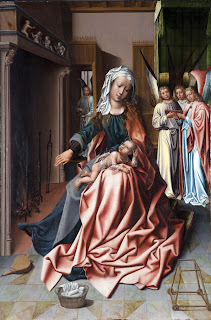 |
| Attributed to Jan Gossaert, called Mabuse (Flemish, 1478-1532), Madonna of the Fireplace, ca. 1500, oil on panel , 33 x 22 1/8 inches. |
Currently on view at the Georgia Museum of Art (GMOA), “A
Divine Light: Northern Renaissance Paintings from the Bob Jones University
Museum & Gallery” surveys devotional art of Belgium, France, Germany, the
Netherlands and Spain in the 15th and 16th centuries. The exhibition explores
Christian faith through setting, pose, gesture and everyday objects.
“Madonna of the Fireplace,” one
of 28 paintings on display from the Bob Jones Collection, was restored in 2010,
revealing its rich, vibrant color. It depicts figures in a highly realistic,
unidealized manner, stresses detail and contains symbolism—all common
characteristics of Northern Renaissance painting. Although the artist of the work remains
unknown, it is most likely one of Jan Gossaert’s contemporaries.
The composition also demonstrates the versatile qualities of
its medium. Made popular in the 15th century by Flemish artist Jan van Eyck,
oil created an avenue for Northern European artists to develop advanced
techniques for paintings that truly came to life. Oil is slow to dry, which
makes it possible to paint in layers and create value directly on canvas.
The Virgin, the central and largest figure, is seated with
Christ Child on her lap. Three singing angels stand behind her praising her as
the Virgin mother and another angel emerges from a doorway with a spoon and a bowl
of milk for the Christ Child. Christ, who is usually depicted sitting upright,
is seen here on his stomach looking up at his mother while she looks down at
him. The pyramid formed by the two figures, along with the use of single-point
perspective, fortifies their significance.
Symbols are found throughout the composition—the objects
strewn across the floor, the furniture, the intricate design of the
fireplace—that indicate wealth, family life, childhood and Christ’s life. Three
prominent symbols include the fireplace, the Christ Child’s walker and the
tiled floor. Although the fireplace is
positioned to the left of the Virgin and Christ Child, it remains a central
fixture in the home that provided families with heat and light after dark. It also
references the Eucharist, as the fireplace was where people baked bread. The
wooden walker, located at the bottom right, is what Christ would have used to
take his first steps and foreshadows the wooden Cross he would bear. The tiles
on the floor form an octagonal pattern indicating Christ’s resurrection.
For an in-depth discussion of “Madonna of the Fireplace” and other
Northern Renaissance paintings, join GMOA for our lectures by Trinita Kennedy and John Nolan on April 12.
“A Divine
Light” runs through July 29.

No comments:
Post a Comment